Market Recap for Tuesday, February 27, 2018
During a day filled with renewed selling, especially in the final 10 minutes, there were 3 key takeways as far as I'm concerned. First, the short-term uptrend appeared to have been broken at the end of the day as gap, price and 20 hour EMA support were lost on the S&P 500:
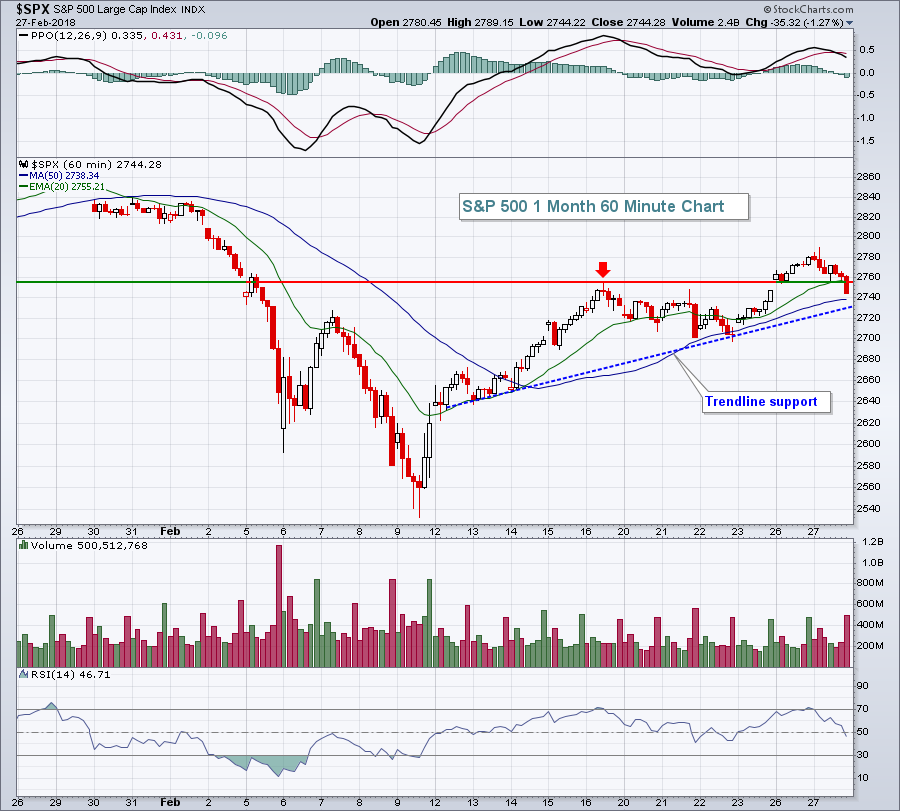 Next support would be trendline support somewhere near 2730. Loss of that level would set up another key price support test in the 2690-2700 area. A move beneath that zone would likely trigger much more fear.
Next support would be trendline support somewhere near 2730. Loss of that level would set up another key price support test in the 2690-2700 area. A move beneath that zone would likely trigger much more fear.
Speaking of fear, that's takeaway #2. The Volatility Index ($VIX), after closing a smidgeon below a very critical 16 level on Monday, soared on Tuesday's selling as you can see below:
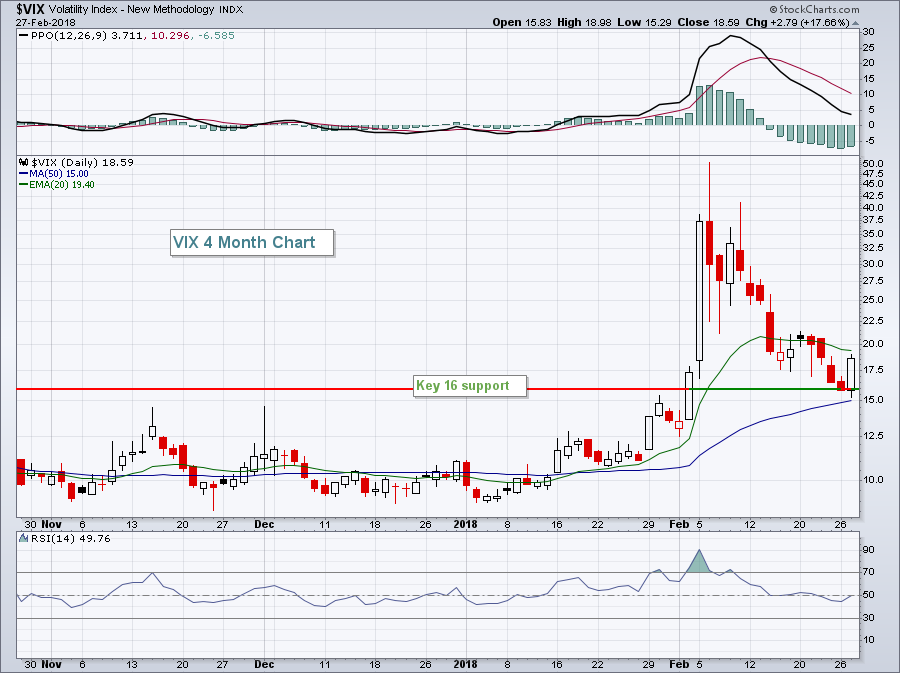 That 17.66% spike in the VIX came at a very opportune time for those in the "bear market" camp. During each of the last two bear markets, the VIX never dropped beneath 16. After barely doing so on Monday, the fear meter surged - a necessary component during a bear market. For now, I'll call it a kick save for sure. I will say this. The next time we see a fresh new recent low in the VIX will likely end all talk of a bear market.
That 17.66% spike in the VIX came at a very opportune time for those in the "bear market" camp. During each of the last two bear markets, the VIX never dropped beneath 16. After barely doing so on Monday, the fear meter surged - a necessary component during a bear market. For now, I'll call it a kick save for sure. I will say this. The next time we see a fresh new recent low in the VIX will likely end all talk of a bear market.
Finally, key takeaway #3 was the resurgent U.S. Dollar Index ($USD). There is a strong positive correlation between (a) the relationship between U.S. Treasury yields and German Treasury yields and (b) the direction of the USD. Occasionally, they get off track, but when they have in the past, it's resulted in a major surge in the USD. Take a look:
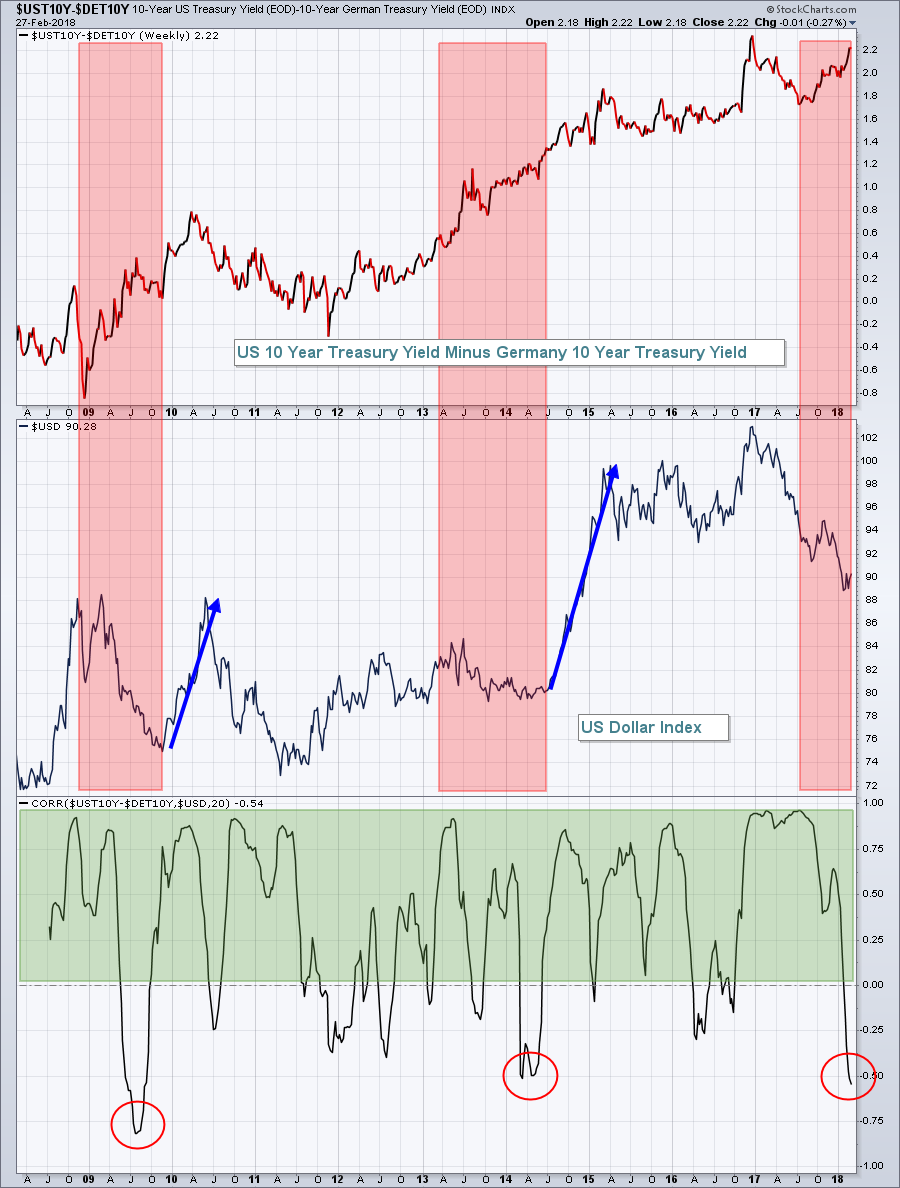 The red circles above show the rare occurrences when the direction of the US treasury yields (vs Germany) diverges from the direction of the US Dollar. Note the blue directional arrows that show what happens next - a surging dollar to play catch up. The red shaded zones highlight the short-term inverse relationships, followed by those dollar surges. It's noteworthy that once again the dollar has ignored the rising US treasury yields and yesterday had one of its strongest days in months. If the dollar does catch fire from this level, it would spell big trouble for gold. Consider your trading strategies accordingly. (If you enjoy this type of analysis, please scroll to the bottom of this article, type in your email address and click the green "Subscribe" button. My blog articles will then be sent to the email address provided as soon as my articles are published. Thanks for your support!)
The red circles above show the rare occurrences when the direction of the US treasury yields (vs Germany) diverges from the direction of the US Dollar. Note the blue directional arrows that show what happens next - a surging dollar to play catch up. The red shaded zones highlight the short-term inverse relationships, followed by those dollar surges. It's noteworthy that once again the dollar has ignored the rising US treasury yields and yesterday had one of its strongest days in months. If the dollar does catch fire from this level, it would spell big trouble for gold. Consider your trading strategies accordingly. (If you enjoy this type of analysis, please scroll to the bottom of this article, type in your email address and click the green "Subscribe" button. My blog articles will then be sent to the email address provided as soon as my articles are published. Thanks for your support!)
All nine sectors fell on Tuesday with financials (XLF, -0.95%) holding up best, while consumer discretionary (XLY, -2.12%) really struggled. A chart of the XLY is featured below in the Sector/Industry Watch section.
Pre-Market Action
Asian markets were rocked overnight with the Hang Seng Index ($HSI) falling more than 400 points in sympathy with yesterday's U.S. action. Europe is holding up pretty well this morning as U.S. futures appear fairly stable. With a bit more than 30 minutes to the opening bell, Dow Jones futures are higher by 50 points.
In earnings news, Booking Holdings (BKNG - formerly priceline.com PCLN) blew out both revenue and EPS estimates after the close on Tuesday and is up more than 8% in pre-market action.
Current Outlook
For those wondering why I don't like gold ($GOLD) or gold miners (GDX), it's mostly due to the metal's and the industry group's inability to outperform the benchmark S&P 500 during the past 15 months - all while the U.S. Dollar Index tumbled. (There is no better tailwind for gold than a falling dollar). Hopefully, after one look at this chart, you'll understand why I rarely discuss gold:
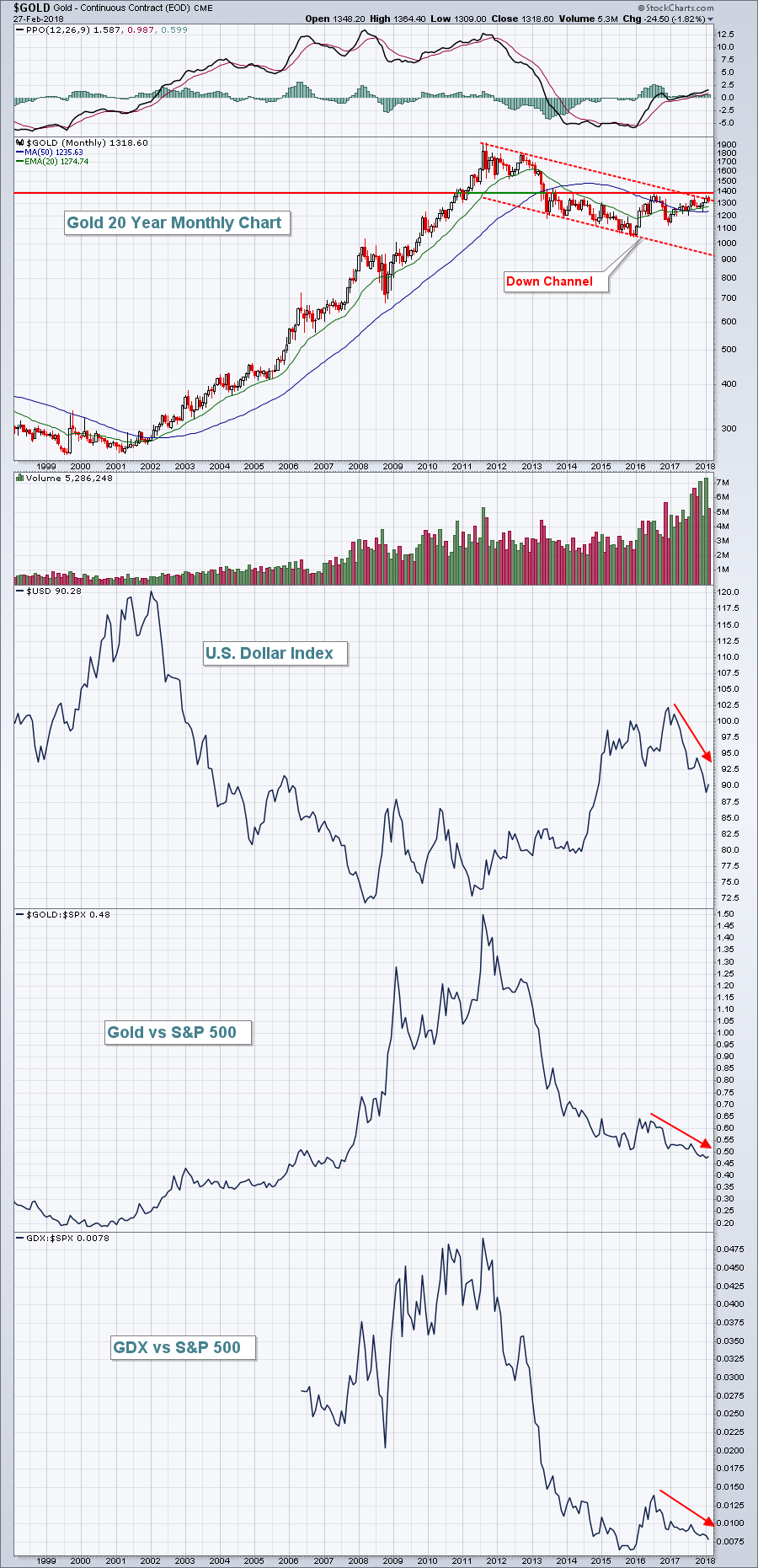 The price of gold has been channeling lower since 2011. The rising dollar since 2011 has put pressure on gold and gold-related stocks since that time as well. Since late-2016, however, the dollar has retreated significantly, yet both gold and gold-related stocks have continued their downward relative spiral. If a rapidly-declining dollar can't jump start gold, what will?
The price of gold has been channeling lower since 2011. The rising dollar since 2011 has put pressure on gold and gold-related stocks since that time as well. Since late-2016, however, the dollar has retreated significantly, yet both gold and gold-related stocks have continued their downward relative spiral. If a rapidly-declining dollar can't jump start gold, what will?
A break above $1400 on gold would be bullish from a technical perspective, but I'd also want to see relative strength vs. the S&P 500 as well. After all, aren't we trying to beat that benchmark index in our trading?
Sector/Industry Watch
Consumer discretionary (XLY) has been the leading sector the past several months and has rallied nicely off the recent panicked lows. But after lagging all other sectors on Tuesday, I wonder if the group is beginning to develop a possible symmetrical triangle. Here's a possible bullish consolidation pattern that could evolve over the next few weeks:
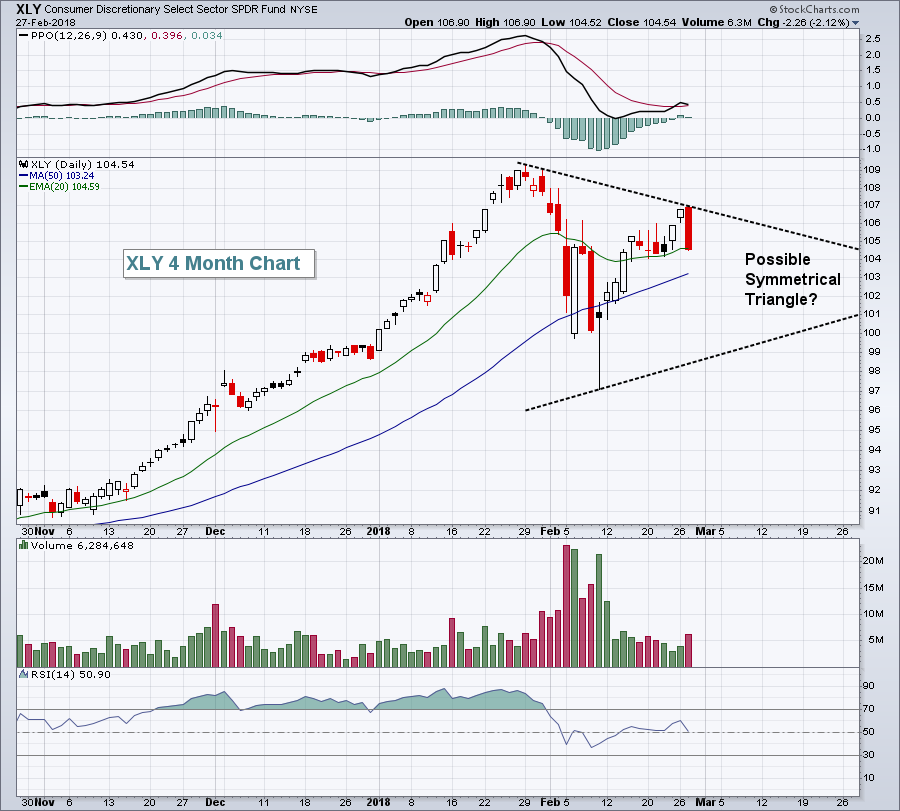 There are countless possibilities as we move forward from here. While a "V" bottom would be the most preferable for bulls in the very near-term, we do have to realize that our major indices soared higher the past 15 months with little consolidation/selling. It would actually be healthier to see an extended base develop in the form of some type of bullish continuation pattern. A symmetrical triangle or bull wedge would be a couple of patterns to consider.
There are countless possibilities as we move forward from here. While a "V" bottom would be the most preferable for bulls in the very near-term, we do have to realize that our major indices soared higher the past 15 months with little consolidation/selling. It would actually be healthier to see an extended base develop in the form of some type of bullish continuation pattern. A symmetrical triangle or bull wedge would be a couple of patterns to consider.
Historical Tendencies
Like the S&P 500 history that I discussed yesterday, the NASDAQ also has seen lackluster action to end the month of February historically. Since 1971, here are the day-by-day annualized returns to close out the month:
February 25: +48.88%
February 26: +7.53%
February 27: -72.60%
February 28: -23.80%
February 29: +2.20% (sorry, no leap year this year)
Key Earnings Reports
(actual vs. estimate):
ADI: 1.42 vs 1.29
LOW: .74 vs .88
TJX: vs 1.28 (still awaiting results)
(reports after close, estimate provided):
CRM: .33
MNST: .37
MYL: 1.41
Key Economic Reports
Q4 GDP - 2nd estimate - released at 8:30am EST: 2.5% (actual) vs. 2.5% (estimate)
February Chicago PMI to be released at 9:45am EST: 65.0 (estimate)
January pending home sales to be released at 10:00am EST: +0.3% (estimate)
Happy trading!
Tom





